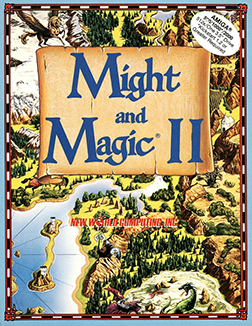Might and Magic II: Gates to Another World
| Might and Magic II: Gates to Another World |
|
|---|---|
 |
|
| Developer(s) | New World Computing |
| Publisher(s) | New World Computing |
| Designer(s) |
Jon Van Caneghem Michaela Van Caneghem |
| Programmer(s) |
Jon Van Caneghem Stephen L. Cox Mark Caldwell |
| Artist(s) | Avril Harrison Jeff Griffeath Kenneth Lee Mayfield |
| Series | Might and Magic |
| Platform(s) | DOS, Amiga, Apple II, Mac, C64, FM-7, MSX, NEC PC-8801, NEC PC-9801, Mega Drive/Genesis, Sharp X1, X68000, SNES |
| Release | 1988 |
| Genre(s) | Role-playing video game |
| Mode(s) | Single-player |
Might and Magic II: Gates to Another World (also known as Might and Magic Book Two: Gates to Another World) is a role-playing video game developed and published by New World Computing in 1988. It is the sequel to Might and Magic Book One: The Secret of the Inner Sanctum.
After the events of Might and Magic Book One: The Secret of the Inner Sanctum, the adventurers who helped Corak defeat Sheltem on VARN take the "Gates to Another World" located in VARN to the land of CRON (Central Research Observational Nacelle). The land of CRON is facing many problems brought on by the encroachment of Sheltem and the adventurers must travel through CRON, the four elemental planes and even through time to help Corak stop Sheltem from flinging CRON into its sun.
While in many ways Might and Magic II is an updated version of the original, the improved graphics help greatly with navigation, and the interface added several functions that facilitated gameplay, such as a "delay" selector which allowed for faster or slower response times, and a spinning cursor when input was required - all features lacking in Might and Magic Book One.
As with Might and Magic Book One, the player used up to six player-generated characters at a time, and a total of twenty-six characters could be created, who thereafter stayed at the various inns across CRON. To continue game continuity it was possible to "import" the characters developed from the first game. Additionally, Might and Magic 2 became the first game in the series to utilize "hirelings", predefined characters which could extend the party to eight active characters. Hirelings were controlled like regular characters but required payment each day; pay increased with level.
Other new features include two new character classes, an increased number of spells, the introduction of class "upgrade" quests and more than twice the number of mini-quests. Also added was "secondary skills" such as mountaineering (necessary for travelling mountainous regions) and linguist (raising the character's intelligence, and necessary for reading certain messages). Each character could have up to two secondary skills. The game introduced an automap feature to the series, activated by training a character in the cartographer skill.
...
Wikipedia
